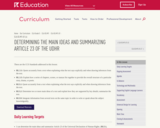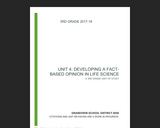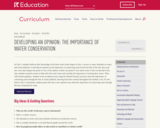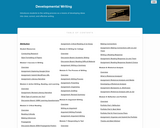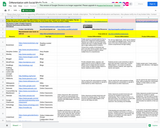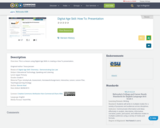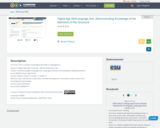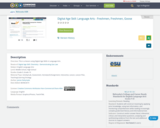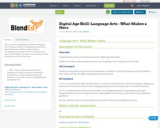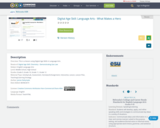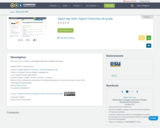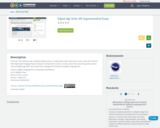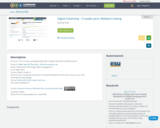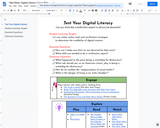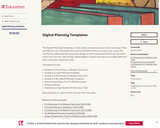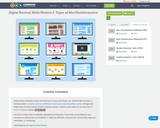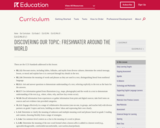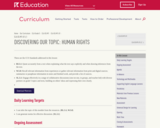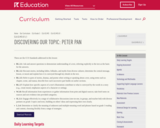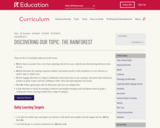Throughout this module, students revisit the module guiding questions introduced in this lesson: "How do writers capture a reader's imagination?" and "What can we learn from reading literary classics?"
In this lesson, students participate in the Infer the Topic protocol to familiarize themselves with the module topic, using resources from the texts they will be reading throughout the module (RL.3.1, W.3.8, SL.3.1).
In Work Time C, students begin reading Peter Pan retold by Tania Zamorsky. The routine of reading aloud as students follow along silently in their heads, and then recounting the chapter will be repeated (with gradual release) in each lesson until students have finished reading the book in Unit 2. Pay careful attention to the routines in this lesson in order to apply them to subsequent lessons.
In this module, a literary classic is defined as a story that was written a long time ago but is still enjoyed today. It is important students understand that one person's idea of a literary classic might be different from someone else's because there are no set rules about what a literary classic is.
Ensure students understand that they are reading Peter Pan as an example of a literary classic and that we can learn things about different time periods in history through reading literary classics. Also ensure that they understand the importance of studying these classics so they can learn from the narrative techniques used.
It is important to be sensitive to students' and families' feelings and experiences with regard to literary classics in the U.S., such as Peter Pan--feelings that may range from very positive to somewhat neutral to very negative. Some people love the adventure, the characters, and the descriptive writing; others find the racism and sexism offensive--for example, the way Mrs. Darling stays at home and looks after duties there while Mr. Darling goes out to work--and also the descriptions of "Indians." These issues are discussed more in the next lesson through an informational context text, but it is important to be prepared to handle them sensitively should they arise.
After reading each chapter, students have time to reflect. Monitor your students and determine whether issues are surfacing that need to be discussed in more detail as a whole group, in smaller groups, or independently.
ELL supports within the Meeting Students' Needs column have changed. Each support is labeled and fully explained the first time it is used, then labeled and condensed in subsequent lessons (see the Unit 1 Overview).
Note that the Mini Language Dive format has changed to reflect a more student-centered approach (see the module overview).
Beginning in this lesson and throughout much of Units 1-2, students are asked to follow along silently as you read the text aloud or to read chorally as a class or with partners. This builds their fluent reading skills. In this lesson, students follow along, reading silently in their heads as the teacher reads Chapter 1 of Peter Pan aloud during Work Time C.
This lesson is the first in a series of three that include built-out instruction for the use of Goal 4 Conversation Cues. Conversation Cues are questions teachers can ask students to promote productive and equitable conversation (adapted from Michaels, Sarah and O'Connor, Cathy. Talk Science Primer. Cambridge, MA: TERC, 2012. Based on Chapin, S., O'Connor, C., and Anderson, N. [2009]. Classroom Discussions: Using Math Talk to Help Students Learn, Grades K-6. Second Edition. Sausalito, CA: Math Solutions Publications). Goal 4 Conversation Cues encourage students to think with other students to expand the conversation. Continue drawing on Goals 1-3 Conversation Cues, introduced in Modules 1-2, and add Goal 4 Conversation Cues throughout Modules 3-4 to more strategically promote productive and equitable conversation. Refer to the Tools page for additional information on Conversation Cues. Consider providing students with a thinking journal or scrap paper. Examples of the Goal 4 Conversation Cues you will see in the remaining modules are (with expected responses):
To encourage students to compare ideas:
Teacher: "How is what _____said the same as/different from what _____ said? I'll give you time to think and write."
Student: "_____ said _____. That's different from what _____ said because _____."
To encourage students to agree or disagree and explain why:
Teacher: "Do you agree or disagree with what your classmate said? Why? I'll give you time to think and write."
Student: "I agree/disagree because _____."
To encourage students to add on to others' ideas:
Teacher: "Who can add on to what your classmate said? I'll give you time to think and write."
Student: "I think that _____."
To encourage students to explain others' ideas:
Teacher: "Who can explain why your classmate came up with that response? I'll give you time to think and write."
Student: "I think what she's saying is _____."
Note that Goal 4 Conversation Cues are not built into the Discussion Norms anchor chart, as these cues are best suited for teachers facilitating student conversations.
